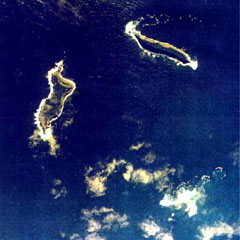Report on Hunga Tonga-Hunga Ha'apai (Tonga) — 29 December-4 January 2022
Smithsonian Institution / US Geological Survey
Weekly Volcanic Activity Report, 29 December-4 January 2022
Managing Editor: Sally Sennert.
Please cite this report as:
Global Volcanism Program, 2021. Report on Hunga Tonga-Hunga Ha'apai (Tonga) (Sennert, S, ed.). Weekly Volcanic Activity Report, 29 December-4 January 2022. Smithsonian Institution and US Geological Survey.
Hunga Tonga-Hunga Ha'apai
Tonga
20.5532°S, 175.3841°W; summit elev. 114 m
All times are local (unless otherwise noted)
The eruption at Hunga Tonga-Hunga Ha'apai continued intermittently during 29 December 2021 to 4 January 2022, though by 3 January activity had significantly decreased. Several surges of Surtseyan activity, with some periods lasting as long as 30 minutes, occurred during 28-29 December; gas, steam, and ash plumes rose at least to 12.2 km (40,000 ft) a.s.l. and drifted N, though the maximum altitude of the ash-rich portion of the plume was lower. Ashfall was local to areas around the island. Discolored water and rafts of pumice were visible in areas around the island on 30 December, and had been observed since the beginning of the eruption. Steam-and-gas plumes were visible throughout the day, interspersed with occasional tephra ejections. The plumes rose as high as 12 km (39,400 ft) a.s.l. and drifted NNE. During the morning of 31 December intermittent plumes of ash, steam, and gas rose to 3 km (10,000 ft) a.s.l. according to the Wellington VAAC, though the steam-and-gas portion of the plume rose as high as 18 km (59,000 ft) a.s.l. as stated by the Tonga Meteorological Services. The Met Services also noted that ash was no longer visible in the emissions starting around noon.
Steam-and-gas plumes were occasional visible in satellite data during 1-2 January. A small ash plume rose 6-7 km (19,700-23,000 ft) a.s.l. during 2220-2230 on 3 January and drifted 10 m NE, dropping in altitude along the way. A cyclone that passed through the area during 3-4 January obscured views of the volcano.
Geological Summary. The small andesitic islands of Hunga Tonga and Hunga Ha'apai are part of the western and northern remnants of the rim (~6 km diameter) of a largely submarine caldera located about 30 km SSE of Falcon Island. The topmost sequence of welded and unwelded ignimbrite units from a caldera-forming eruption was 14C dated to 1040-1180 CE (Cronin et al., 2017; Brenna et al. 2022). At least two additional welded pumice-rich ignimbrite units and nonwelded pyroclastic flow deposits, below paleosols and other volcaniclastic deposits, indicated more very large previous eruptions (Cronin et al., 2017; Brenna et al. 2022). Several submarine eruptions have occurred at this caldera system since the first recorded eruption in 1912, including 1937 and S of the islands in 1988. A short eruption in 2009 added land to to Hunga Ha'apai. At that time the two islands were each about 2 km long, displaying inward-facing sea cliffs with lava and tephra layers dipping gently away from the caldera. An eruption during December 2014-January 2015 was centered between the islands, and combined them into one larger structure. Major explosive eruptions in late 2021 initially reshaped the central part of the combined island before stronger activity in mid-January 2022 removed most of the 2014-15 material; an even larger eruption the next day sent an eruption plume high into the stratosphere, triggered shock waves through the atmosphere and tsunami across the Pacific Ocean, and left only small remnants of the islands above the ocean surface.
Sources: Wellington Volcanic Ash Advisory Center (VAAC), Tonga Geological Services, Government of Tonga, Tonga Meteorological Services, Government of Tonga

